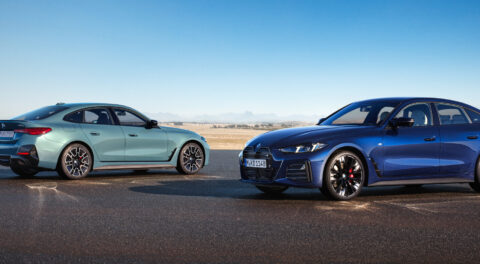BMW is in a state of change right now, with electric drivetrain production taking the place of engine manufacturing, and a new design language permeating its way through the model portfolio. Yet even as century-old factories are being retooled for an electrified future, the BMW 2 Series remains a sort of constant in that it delivers what first drew many of us to the brand: a rear-wheel-drive sport coupe that’s practical enough to use on a daily basis. Something that’s just at home in the grocery store parking lot as it is traversing your favorite backroad.
If you recall the launch of the first-generation 2 Series coupe, which arrived for the 2014 model year, the car was billed as a spiritual successor to the 2002, a model that was integral to the founding of the BMW CCA. BMW went as far as using the 2002 in advertising for the 2 Series, and Car and Driver eventually compared an M235i to a 2002tii to see what BMW was talking about. The amount of 2002 DNA which finds itself in the new 2 Series coupe is even greater than before, and is now evident in its styling, most noticeably the headlights. Instead of BMW’s contemporary dual LED ring design, the headlights of the G42 2 Series are mounted high on the front end, and their circular shape is said to have been inspired by the 2002, which came from a time before BMW started fitting quad headlamps to its cars.
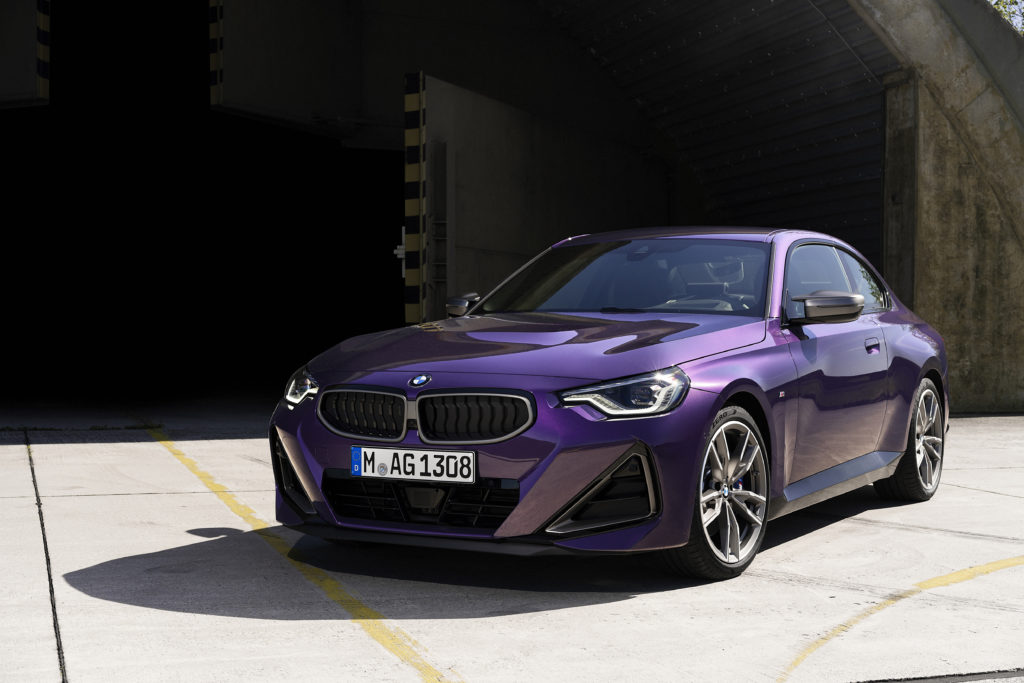
The headlights frame enlarged, but horizontally-oriented kidneys which meet in the middle just below the roundel. The front clip is a breath of fresh air for many who are likely glad to see that the new Two more closely follows the look of the 8 Series than the 4 Series. The aesthetic properties of the headlights are mirrored on the rear end with the tail lights, which are partially integrated with the aerodynamic trunk lid and situated above the bumper that accentuates the wide fenders of the model with reflectors on either side. Speaking of the body itself, the sheet metal of the G42 2 Series is significantly more aggressive than its predecessor, with wide, muscular flared fenders housing the wheels and tires. When viewed in combination with the lights and black lower portions of the body including the side skirts and rear diffusor on the M240i, the look is particularly athletic.
Both the M240i and the 230i use the same body panels, but the G42’s footprint has grown over the F22 in nearly every dimension. While the outgoing F22 M240i xDrive is 175.9 inches long, 69.8 inches wide, 55.4 inches tall, weighs 3,662 pounds, and has front and rear tracks of 59.7 inches and 60.4 respectively, along with a 105.9-inch wheelbase, the G42 M240i xDrive is 179.4 inches long, 72.4 inches wide, 55.3 inches tall, weighs 3,871 pounds, and has front and rear tracks of 62.2 inches and 6.28 respectively, along with a 107.9-inch wheelbase. Weight distribution comes in at 51.6% front and 48.4% front and rear for the 230i, and 53.1% and 46.9% for the six-cylinder M240i xDrive, balance which is achieved through the use of aluminum for the hood and front fenders.
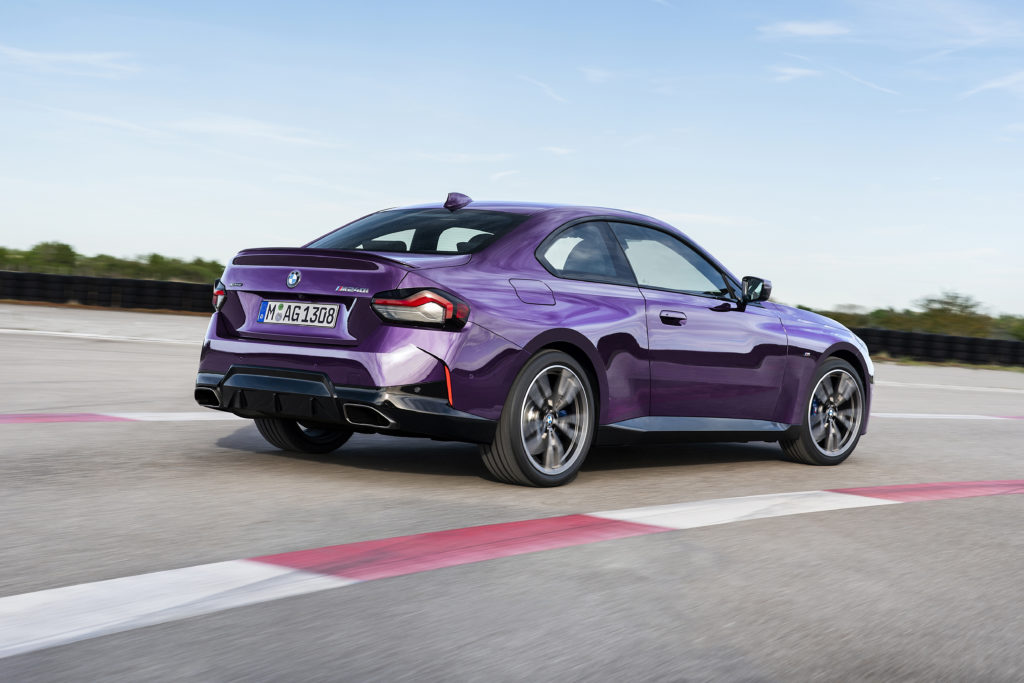
The drag coefficient (Cx) of the M240i xDrive drops from 0.34 to 0.30 from F22 to G42, and BMW’s stated zero-to-60 mph acceleration time drops from 4.2 seconds to 4.1. The dimensional figures vary slightly for the 230i, which will be be offered in rear-wheel-drive form alongside the M240i xDrive starting in November. The rear-wheel-drive version of the M240i is slated to arrive next year along with the 230i xDrive, and neither model will be offered with a manual transmission. The exclusive drivetrain choice of the ubiquitous ZF eight-speed automatic is disappointing to manual fans, but comes as no surprise given the lack of a manual transmission in the G20 3 Series and the current 4 Series lineup which now includes a coupe, convertible, and Gran Coupé. It’s not the end of the story for the manual transmission in the 2 Series though, as the next-generation M2 is still expected to be offered with one, just like the current M3 and M4.
Although BMW sells two distinct versions of the 2 Series—the front-wheel-drive, four-door Gran Coupé, and the enthusiast special rear-wheel-drive two-door coupe—the two share essentially nothing other than a roundel and perhaps a few bits and pieces here and there, most notably within the cabin. While the F44 2 Series Gran Coupé rides on BMW’s UKL modular platform, which is shared with the X1, X2, and a few Mini crossovers, the G42 2 Series is built on BMW’s CLAR rear-wheel-drive platform, which underpins everything from the 3 Series, Z4, and i4 to the 7 Series and 8 Series.
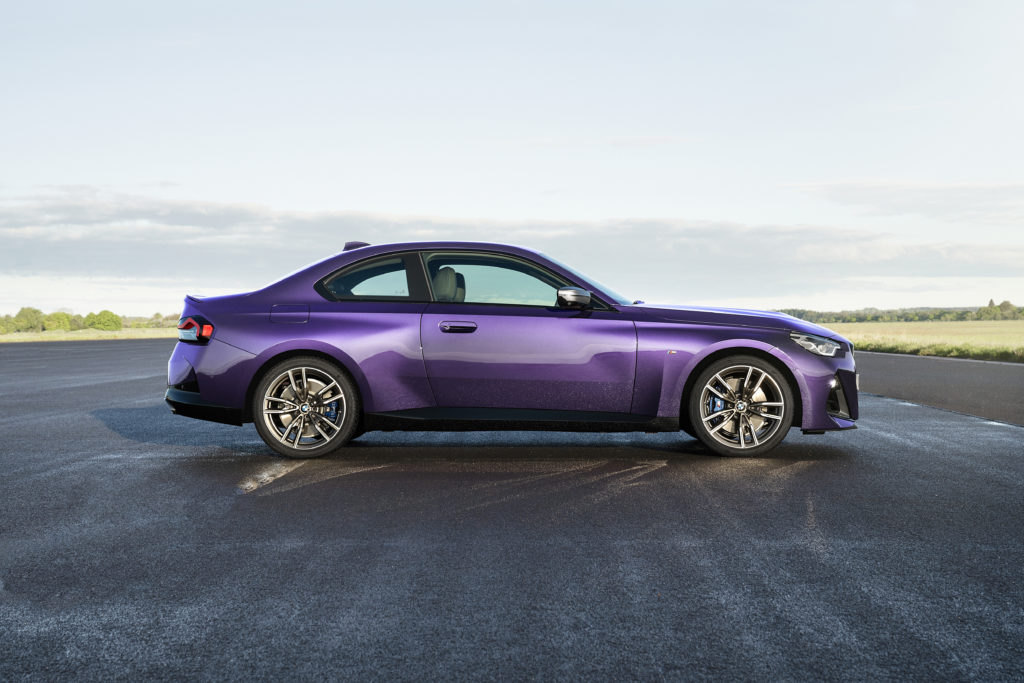
A glance at the cabin reveals much of what one needs to know: the design and layout come courtesy of the 3 Series and 4 Series, and the technology suite of both is available in the 2 Series including BMW’s current iDrive System 7.0 with a digital instrument cluster (analog gauges are standard). Material choices have been improved over previous BMW generations, and passenger room is expanded proportionally. While occupants of the outgoing F22 were confined to 41.5 inches of front legroom, 33 inches of rear legroom, 54.4 inches of front shoulder room, 43.4 inches of rear shoulder room, 40.1 inches of front headroom, and 36.5 inches of rear headroom, the G42 boasts 41.8 inches of front legroom, 32.2 inches of rear legroom, 55.9 inches of front shoulder room, 51.7 inches of rear shoulder room, 39.8 inches of front headroom and 35 inches of rear headroom, and overall passenger volume has been expanded by three cubic feet. Trunk volume, on the other hand, has shrunk from 13.8 cubic feet to ten.
Sales of G42 M240i xDrive and 230i in the U.S. are slated to begin in November. The 230i starts at $37,345 including destination, and the M240i has a base MSRP of $49,545. The 230i xDrive and rear-wheel-drive M240i are scheduled to arrive in 2022. The M240i is motived by the most powerful version of BMW’s 3.0-liter B58 turbocharged inline-six engine, which develops 382 horsepower from 5,800 to 6,500 rpm, and 369 pound-feet of torque from 1,800 to 5,000. The 230i’s engine is the BMW B48 turbocharged 2.0-liter four-cylinder, with 255 horsepower from 5,000 to 6,500 rpm and 295 pound-feet of torque from 1,550 to 4,400, and both are backed by the aforementioned ZF eight-speed sport automatic transmission. The array of available colors is similar to what’s offered on the 3 Series, but with two new finishes: Brooklyn Grey Metallic, and the eye-catching Thundernight Metallic on display here.

Which one should you actually buy, though? Even with the 2 Series having been on sale for seven model years and an array of model variants, the choice is remarkably subjective and not as obvious as one might think. BMW describe the M2 as the most popular M car since its introduction, but on the opposite end of the spectrum, Road & Track said only the four-cylinder 228i “channels the old M3’s balance and approachability,” back in 2016 when it was tested alongside the M235i, M2, and an E30 M3. The one caveat is that all three test cars had manual transmissions, something that won’t be the case with the new 2 Series. Nevertheless, the unencumbered poise of the 230i remains worth noting, as it may be the closest thing to a BMW 2002 one can buy new.
An M2 will eventually join the lineup and assume the position as the most potent and uncompromising 2 Series variant, but until then, the M240i M Performance automobile is the default choice for those who want a six-cylinder engine and a taste of the M car driving experience, and it’s unlikely to disappoint in terms of performance, having gained the most potent version of the B58 engine.
At the end of the day, the driving enthusiasts among us are unlikely to go wrong with any version of the 2 Series.—Alex Tock
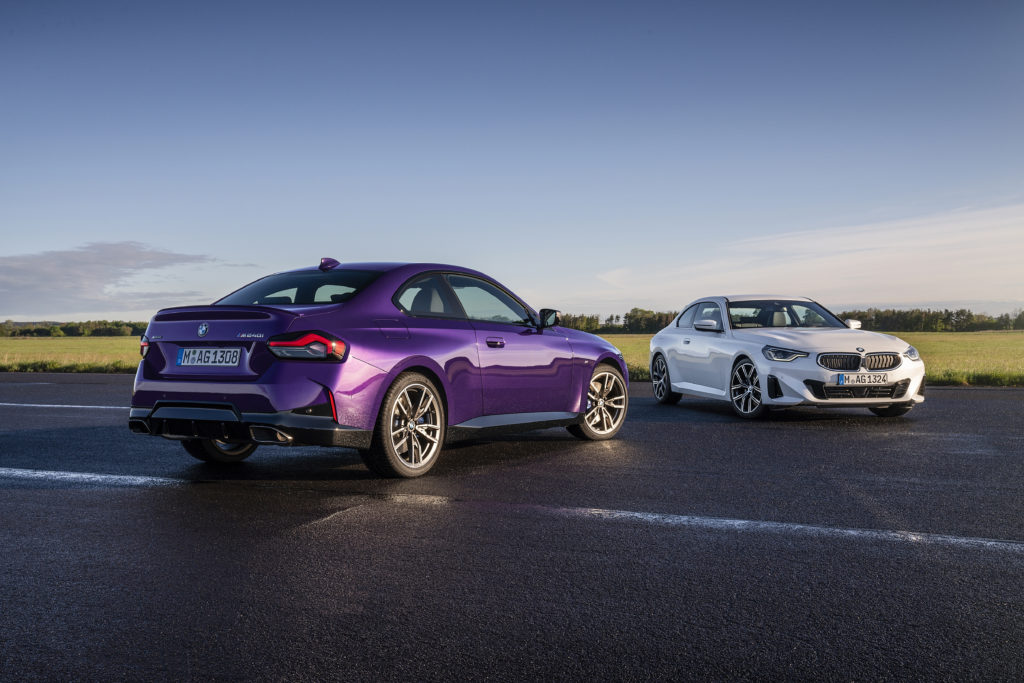
[Photos courtesy BMW AG.]








